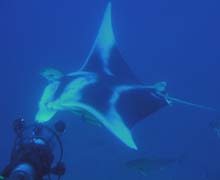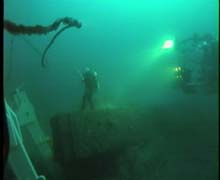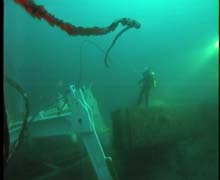
A huge manta ray is seen from the Johnson Sea-Link submersible while it explores the Monitor wreck. Click image for larger view and detailed explanation.

In this image, the saturation diver, the Johnson Sea-link and the spider can be seen. Click image for larger view and detailed explanation.

The saturation diver works to properly position the spider. Click image for larger view and detailed explanation.
More Submersible Dives
July 20, 2002
John Broadwater
Monitor National Marine Sanctuary
During the week of July 15-18, NOAA conducted four days of observation dives using the Johnson-Sea-Link II (JSL II) submersible (see the report on the first submersible dives). JSL II, owned by the Harbor Branch Oceanographic Institution ![]()
![]() , can accommodate four persons and is equipped with digital still and video cameras. Ten dives were made on the Monitor, giving sanctuary staff and visitors the opportunity to view the wreck firsthand. On the 17th and 18th, we were able to observe and document the “Spider” which had just been lowered into position over the turret on July 17.
, can accommodate four persons and is equipped with digital still and video cameras. Ten dives were made on the Monitor, giving sanctuary staff and visitors the opportunity to view the wreck firsthand. On the 17th and 18th, we were able to observe and document the “Spider” which had just been lowered into position over the turret on July 17.
JSL II, built in 1975, is capable of reaching depths of 3,000 feet (915 m) and remaining at that depth for several hours. The versatile submersible can be fitted with a variety of scientific recording and sampling equipment. For our purposes, we used the high-resolution still and video cameras as our main tools. We documented the turret from the outside, then hovered above as if we were in a helicopter, recording the features inside the turret. Both of the Dahlgren cannons and carriages had been partially uncovered, so we were able to get a good look at them and document their positions within the turret.
On Wednesday, while hovering near the turret, Pilot Phil Santos reported that the water temperature had just risen almost four degrees Celsius (7 degrees F) and the water was shimmering in front of the sub’s clear acrylic sphere as warmer Gulf Stream water moved across the Monitor’s hull. This sudden change was a dramatic demonstration of the dynamic environment in which the Monitor rests. As we watched this phenomenon, we noticed that the saturation diver, Rusty Deen, had climbed onto the armor belt and was motioning to us. At first, we thought he needed help or a tool, but his movements soon made it clear that he wanted us to come closer so he could “shake hands” with the JSL’s mechanical manipulator arm! Phil obliged, as our remotely operated vehicle (ROV) looked on, and Rusty was soon happily back at work.
At one point on Thursday’s dive, the Monitor was surrounded by a diving bell with two saturation divers, a dive stage with two surface-supplied divers, the ROV, the JSL and a variety of hoses, pipes and tools. Overhead were the derrick barge Wotan with more than a hundred people, and the Research Vessel Seward Johnson. The Monitor’s inventor, John Ericsson, would have been very pleased to see his little ship receiving so much attention.
With the Spider deployed, work focused on getting the Spider into the correct position, a process that is still underway. Divers are using water hoses and suction dredges to remove seabed material around each of the eight legs of the Spider so that the legs will sink deep enough for their pads to be slid beneath the rim of the turret.
Thursday night, the weather turned bad again, forcing cancellation of Friday’s planned submersible dives. We also had a very impressive thunderstorm on Saturday night. However, work continues on the Spider. Within the next few days, we will resume excavation inside the turret.
Sign up for the Ocean Explorer E-mail Update List.

































